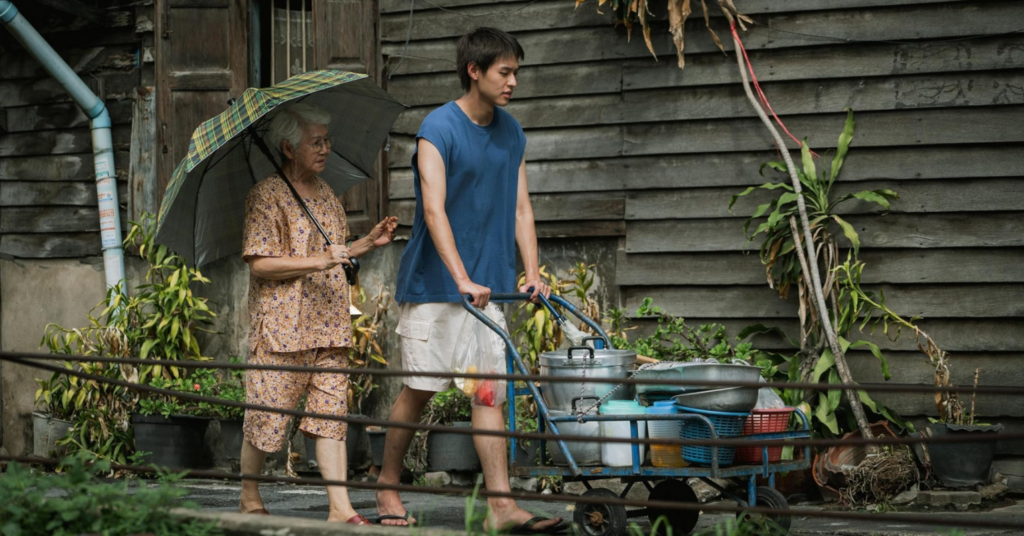First Impressions: How To Make Millions Before Grandma Dies

Love is an enigma that enriches the human experience. This theme is central to Pat Boonnitipat‘s latest film, How To Make Millions Before Grandma Dies. Through this GDH production, Boonnitipat invites the audience to ponder a fundamental question: Is it possible for genuine love to emerge from relationships initially driven by personal gain?
The film explores this complex dynamic by weaving a narrative that challenges the traditional boundaries of love and obligation. As the characters navigate their interactions, the story delves into the heart of whether authentic affection and connection can develop despite motives that are seemingly self-serving. This intriguing premise sets the stage for a heartfelt examination of the true nature of love.
Conundrum of Love
The story revolves around M (Billkin), who chooses to look after Amah (Usa Samekham), his grandmother in hopes of securing an inheritance. This decision is driven by the news of Amah’s terminal cancer and influenced by his cousin Mui (Tontawan), who had taken care of their sick grandfather. And as a result, Mui successfully inherited a luxurious house.
However, M’s efforts to win Amah’s heart are not easy. He must compete with his uncles, Kiang (Sanya Kunakorn) and Soei (Pongsatorn Jongwilas), who also approach Amah during her illness. This turns into a competition that adds tension and complexity to M’s mission, highlighting the transactional nature of his initial intentions.
As M decides to stay at Amah’s house, he gradually gets to know his family better. M’s newfound proximity to his family allows him to understand the true value of familial bonds beyond mere inheritance. Through this journey, M discovers that genuine care and love can flourish even within seemingly transactional relationships.
Capturing Sympathy through Engaging Narrative Style

How To Make Millions Before Grandma Dies captivates the audience with its clear and straightforward storytelling. The simple plot makes it easy to follow along, allowing viewers to fully engage with the characters’ thoughts and emotions. Director Pat Boonnitipat does an excellent job of showing character development through small actions and decisions. For example, M’s casual way of scattering flowers at a grave or Kiang’s awkwardness during family gatherings reveal a lot about their personalities without overwhelming the viewer.
Boonnitipat’s ability to bring together M and Amah’s very different worlds is impressive. At first, their perspectives clash dramatically, but the director carefully builds their relationship through various challenges, revealing a deep connection over time. The outstanding performances by Billkin as M and Usa Samekham as Amah add to the film’s appeal. Their strong on-screen chemistry brings real emotional depth to the story, making the heartfelt moments especially moving.
Social Context and Cinematic Excellence
Beyond the family drama, How To Make Millions Before Grandma Dies delves into the socioeconomic backgrounds of its characters, which enriches the narrative. The stark differences between Kiang’s affluence, Soei’s debt-ridden life, and Amah’s financial struggles offer a comprehensive perspective on each character’s motivations. These contrasts deepen the audience’s understanding of themes like inheritance, family, love, and spirituality.

The film also addresses language barriers by highlighting Amah’s fluency in Teochew compared to M’s struggle with the language. The detail underscores the cultural and generational gaps between them, adding layers to their relationship. Cinematically, the film takes a natural approach, offering an elegant and genuine picture of daily life in Thailand, from busy streets to quiet houses. The shots not only capture these beautiful settings but also intensify the characters’ emotions, avoiding any excessive overemphasis and helping to establish the plot cohesively. The long shot depicting M’s childhood memories with Amah near the film’s conclusion, for instance, heightens the emotional impact, making the story even more engaging.
Symbolic Characters and Gender Dynamics
The emotional depth of How To Make Millions Before Grandma Dies is further enriched by characters like Rainbow and M’s mother (Sarinrat Thomas). By embodying pure love and selflessness, they serve as juxtapositions to the opportunistic Kiang, Mui, and initially M, accentuating the film’s exploration of genuine affection versus transactional relationships.
Boonnitipat also subtly addresses established gender inequalities within the family structure. Amah’s desires often clash with patriarchal norms, depicted through her sarcastic remarks as a means of coping with her suppressed feelings. While this aspect adds a layer of complexity to the narrative, the film could delve deeper into the Amah’s relationship with her siblings to provide a clearer view of the gender dynamics at play.

Emotional Resonance Across Generations
Inspired by true stories found in every family, How To Make Millions Before Grandma Dies succeeds in delivering a heartwarming drama that resonates with audiences of all ages. The evolving bond between M and Amah is beautifully portrayed; it reminds viewers of the conundrum of love and its power to bring out the humanity in everyone, even in the most unexpected circumstances. The film’s gentle yet profound exploration of love within a transactional framework leaves a lasting impact, showcasing Boonnitipat’s skills in storytelling and character development.
Interested in Thai cinema? Read our piece about the series “Shine” here!



